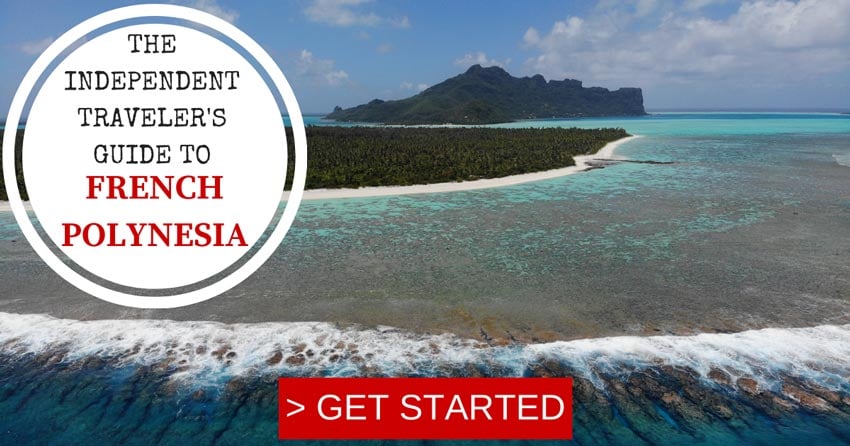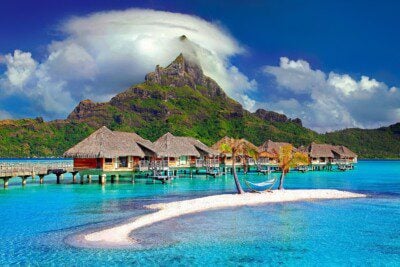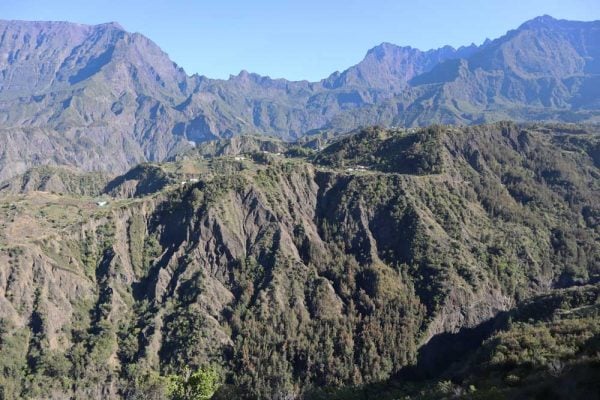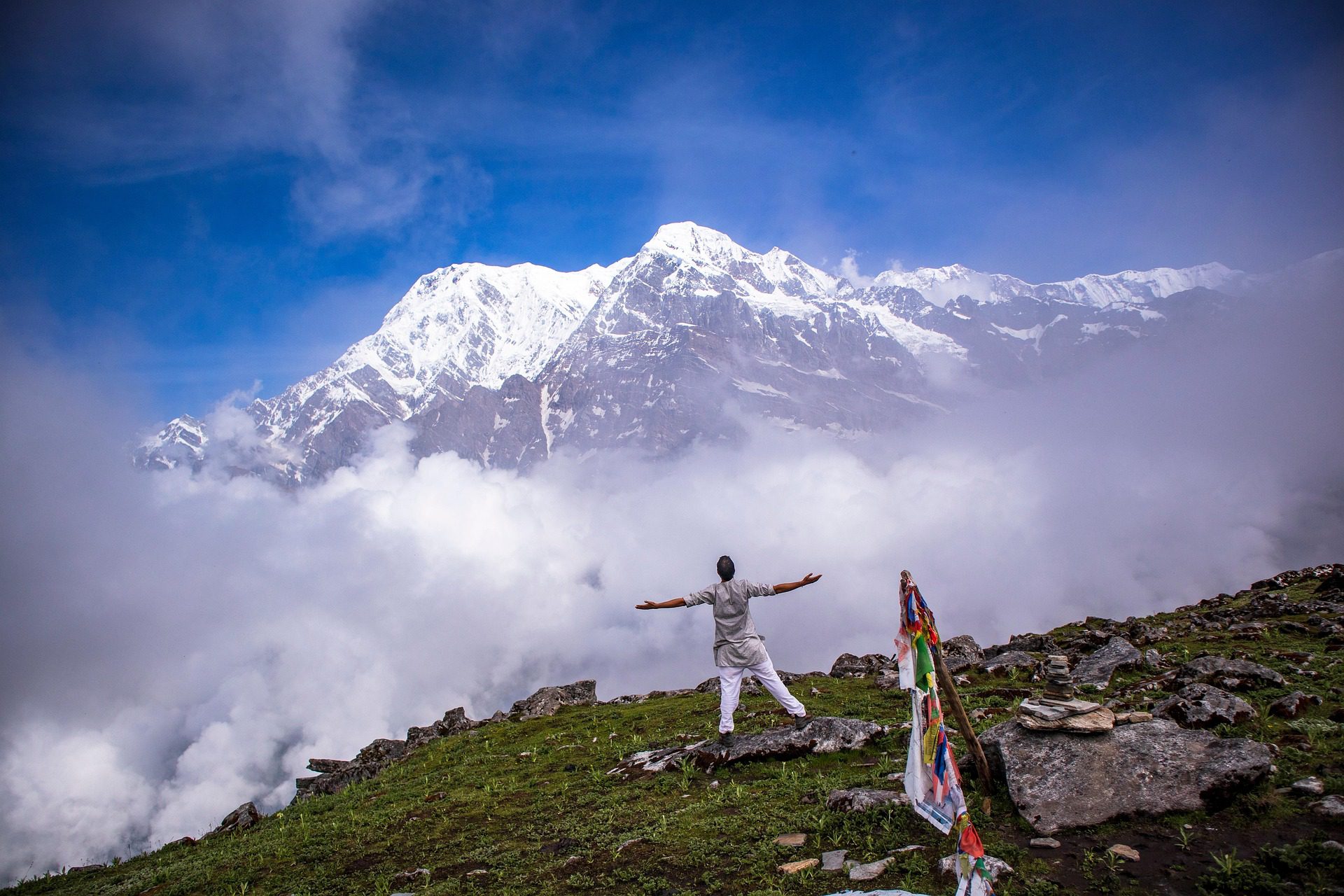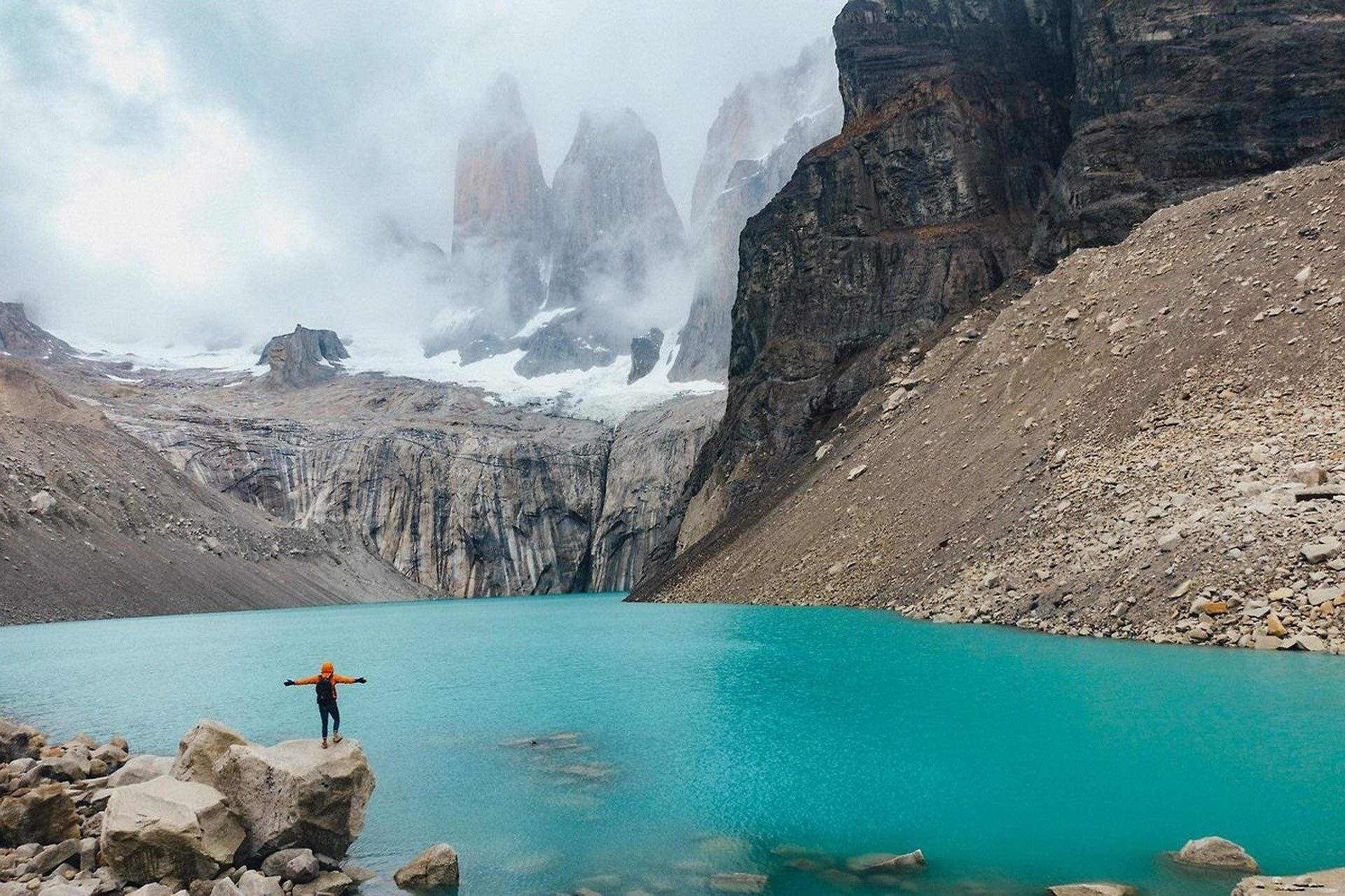Traveling in French Polynesia During COVID: Part 2 – Maupiti
The global epidemic seems like the worst time to travel but I discovered it to be the cure for months of low energy and despair. This is the story of a six-week island-hopping journey in French Polynesia during COVID-19. In this post, we’ll head to what I consider to be the prettiest island in French Polynesia.
Last week, we started the journey in Tahiti, exploring its majestic valleys and road-tripping to the island’s far corners. This week, we’ll head to Maupiti and discover the magic and beauty of an island that continues to resist the global pace of change.
Heading to French Polynesia? In-depth island guides to all 5 archipelagos await you, including sample itineraries and essential travel tips & tricks.
Tahiti, Tailor Made!
The Islands of Tahiti are among the last places to be colonized by mankind, 118 islands, each with its unique personality.
Get expert advice and assistance with planning your trip to the destination where tropical dreams come true!
The most scenic flight in French Polynesia
Maupiti lies at the very edge of the Society Islands, French Polynesia’s collection of stereotypical high islands partially trapped in magnificent blue lagoons. Reaching Maupiti from Tahiti takes about 50 minutes by plane and, with no assigned seats on Air Tahiti flights, if you place the right gamble and sit on the correct side, you are treated to the most scenic flight in French Polynesia. The ATR flies relatively low over the entire archipelago, including Bora Bora, before circling Maupiti on its final approach.
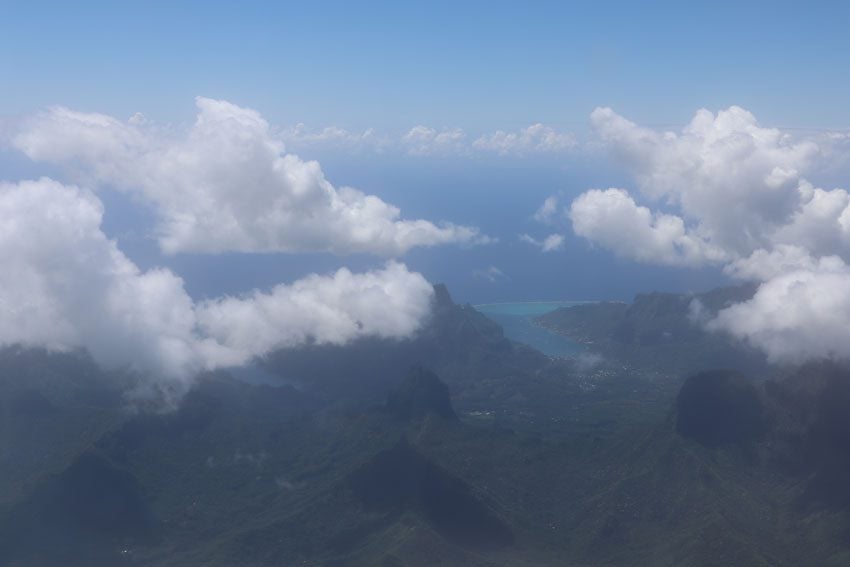
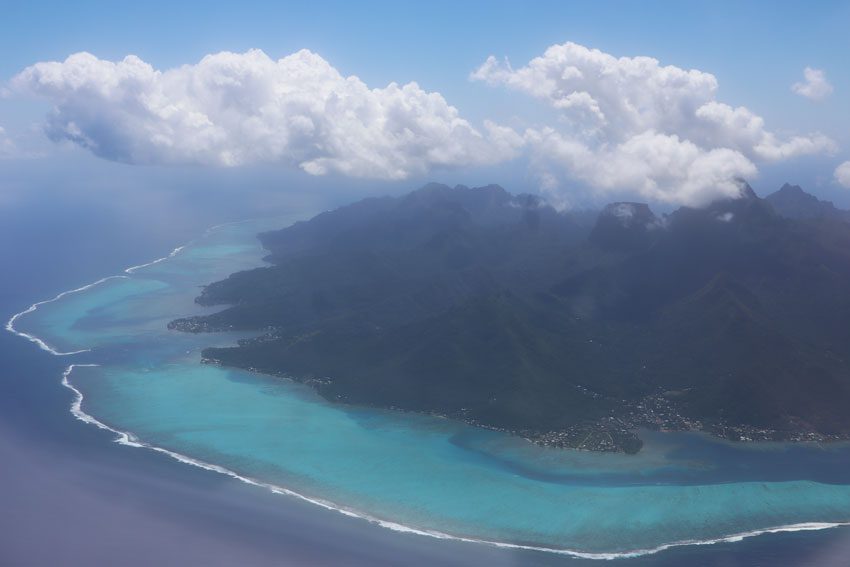
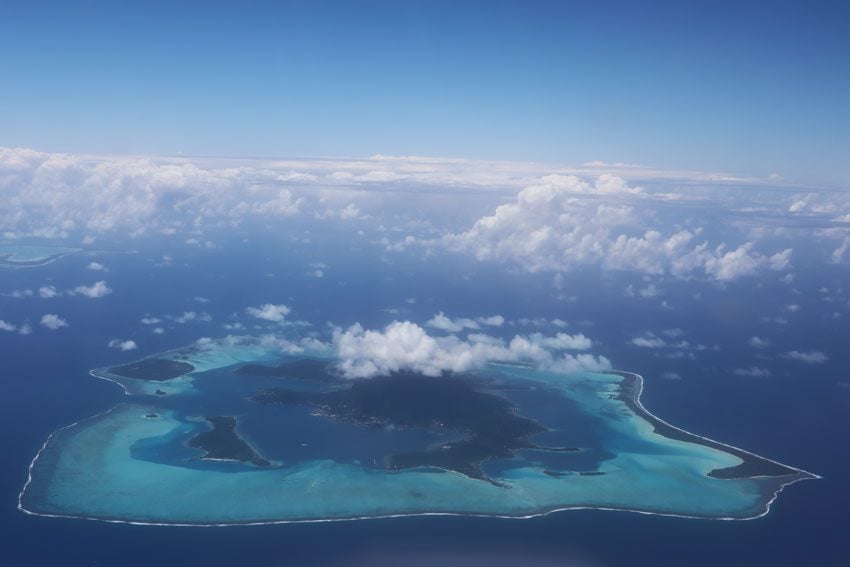
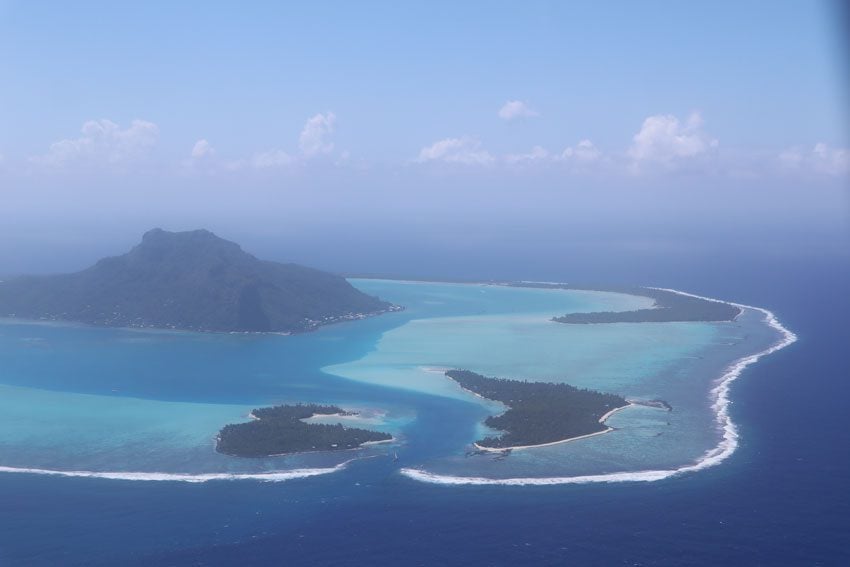
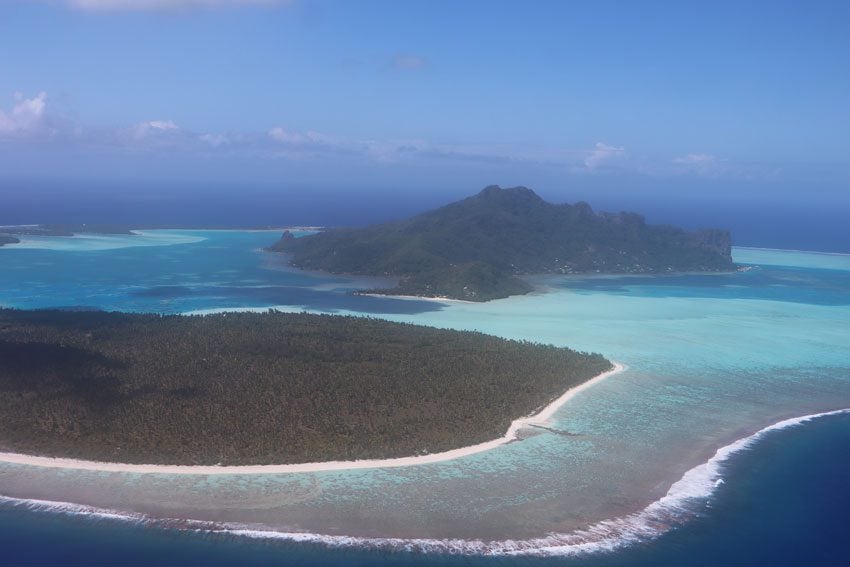
The preserved island
Many people I met in Tahiti were wondering why I was heading back to the same island for a third visit. After all, it’s rare we return to the same destination twice, let alone three times. To me, if Google would be required to return a single result for a search of “classic tropical island”, Maupiti would be it. I first visited Maupiti in 2015 and this island has always been on my mind.
Let’s start with the island’s topography, a miniature version of Bora Bora, so beautifully carved by nature over the course of millennia. The oldest island in the chain, Maupiti’s high peaks have substantially sunk into the depths of the ocean, a cruel act of nature in this part of the world that’s also responsible for creating immense inner lagoons. With a surface area of just 12 km2, Maupiti’s main island is small enough to be circled on foot and its outer islets, known as motu, are the perfect setting for a day of beachcombing.
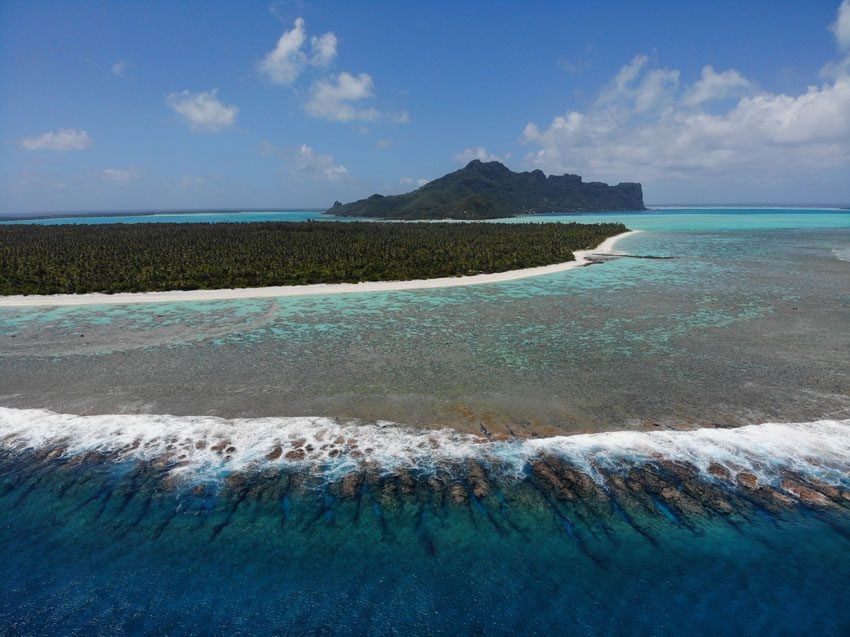
No matter how impressive an island is from a geological perspective, what truly makes a South Pacific island unique is the local population and the vibe. The 1,300 or so residents that call Maupiti home have decided years ago to preserve their beautiful island and to prevent any form of mass tourism. There are no resorts or hotels around here, just local family-owned and operated pensions where guests get to know each other and their Polynesian hosts. Things move slowly in Maupiti. The secret to a successful visit is to adapt yourself and embrace the beautiful pace of life.
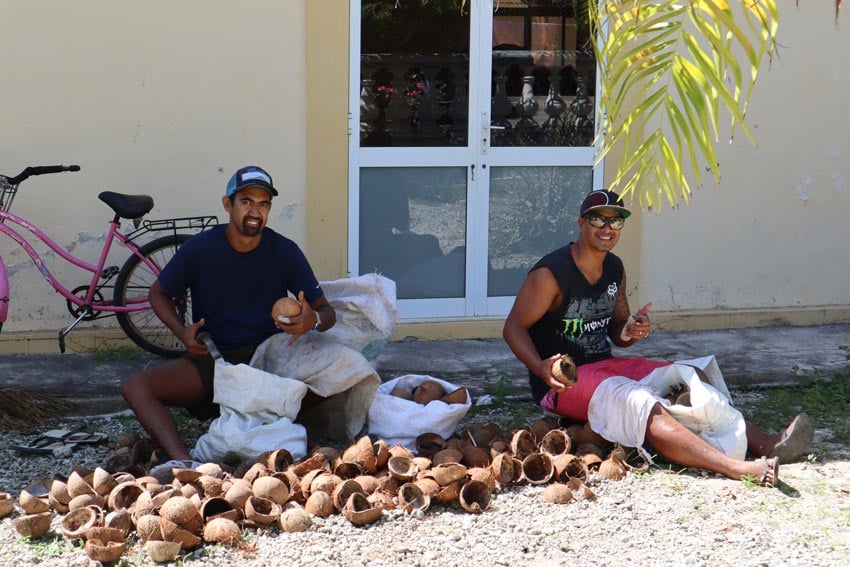
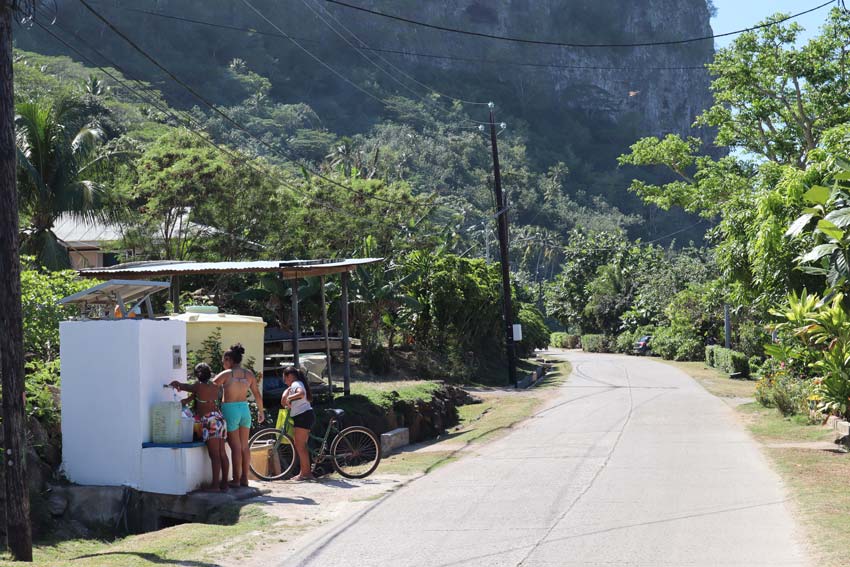
A different kind of welcome
The small airport located on one of the motu is always the scene of contradicting emotions. On the one hand, you never experience a plane emptying so quickly as you do in Maupiti, with excited tourists that can’t wait to begin exploring the island. On the other hand, as the queue for reclaimed luggage meets the queue for boarding the departing flight, the sense of elation mixed with the sadness of departing visitors. “Will we ever see this paradise again?” After a long “island time” wait, checked luggage finally arrives only to now be somehow rolled across 50 or so meters of coral gravel to the taxi boat that takes you to the main island.
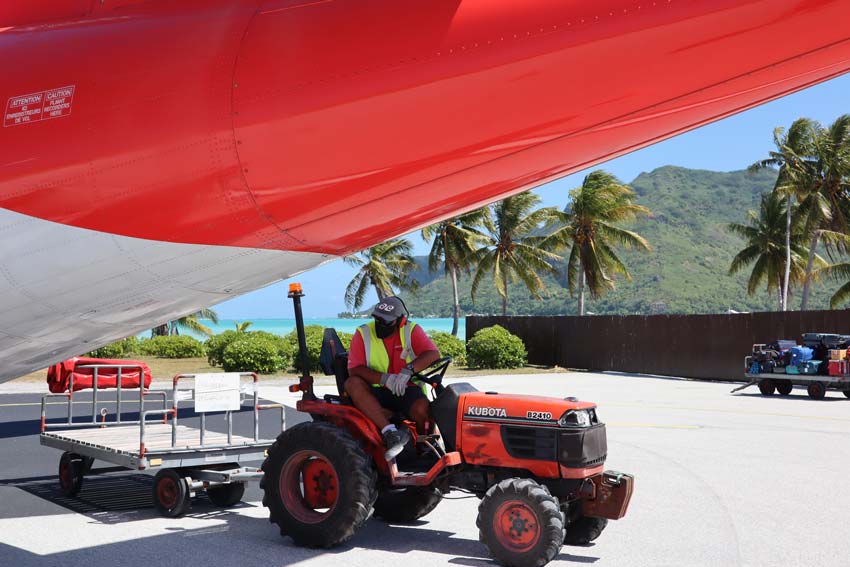
In Tahiti, daily life seemed little interrupted by COVID-19, at least during the start of September. The majority of the population was wearing masks in indoor public places, but restaurants and bars were all open. In Maupiti, it was clear that things were a little different. Although there were no reported cases (the first one was discovered on October 30), the more traditional population on the island was taking precautions.
The first sign was already at the small airport. With plexiglass understandably hard to get, duct tape is stretched between two polls to create a division between customers and staff. It’s impossible to see one another, but sadly, we have already gotten accustomed to the social division forced upon us by the virus.
I was greeted at the pier with a flower necklace (hei) and a fist bump by Dawn from Pension Tautiare Village. It’s the third time I am staying with Dawn, who runs a superb pension, but it was impossible to see her smile beyond the flowery face mask. Don’t get me wrong, I feel absolutely privileged to be welcomed in French Polynesia and Maupiti in particular during this crazy time.
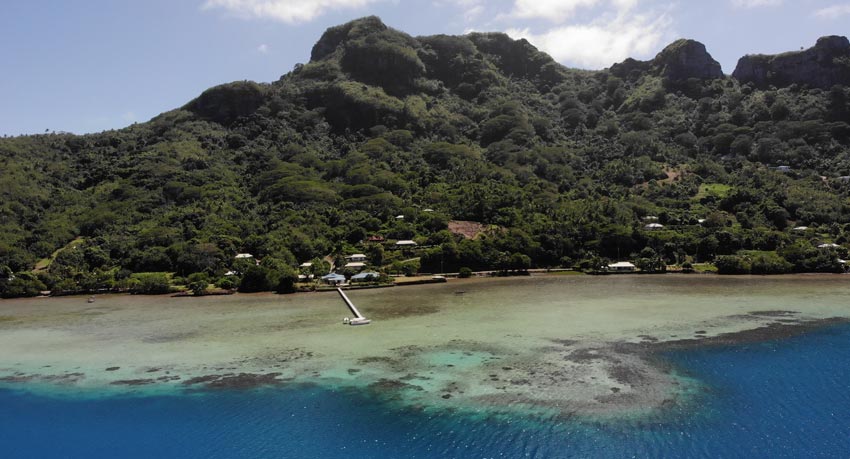
Dawn tells me that while some locals are not happy with the return of tourists to Maupiti and the risk they bring with them, the majority of the local population, who depend on tourism for their livelihood, understand that this risk must be managed. As we hop into the 4X4 en route to the pension, schoolchildren on bicycles are either returning home or hitting the beach, all wearing face masks.
Tereia Beach
With only a few hours before dinner, I head to Tereia Beach, the finest beach on the main island and a favorite gathering spot. While most tourists use beach bicycles to get around the small island, I prefer to walk. Exploring Maupiti on foot allows me to hear, smell and fully absorb the myriad of sounds and colors as you’re slowly making your way around this tiny island.
Though I do discover that Maupiti will finally (maybe) get an ATM installed next year, I find that little has changed since my last visit in 2017 and that is exactly why I keep coming back. Gesturing hello to every passing scooter and greeted with a warm ia orana by cyclists and locals catching some shade on their veranda, I feel back at home.
The short walk to the beach reveals the magic and beauty of Maupiti. Usually on the islands, when you hear something falling, it’s the sound of a falling coconut. But these days in Maupiti, it’s apparently the turn of the mangos. The roadside is abundant with centuries-old trees heavy with ripe fruit. Just collect one that has recently fallen, crack open with your teeth and enjoy. It’s so refreshing under the afternoon sun.
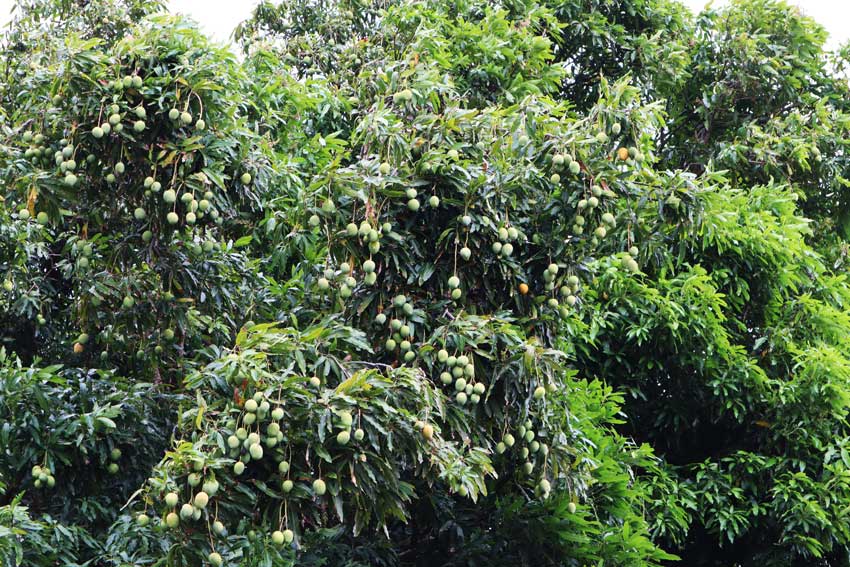
It’s not only mango season right now. Football-sized breadfruit is ready to be picked, noni, banana, grapefruit, and flowers of all colors are abundant in every garden. No matter how dilapidated a house may be, gardening is taken very seriously. Every resident takes great care of their garden as if trying to outdo their neighbor. It’s also not strange to see a grave on the front lawn. In the absence of a communal cemetery, locals bury loved ones on the property.
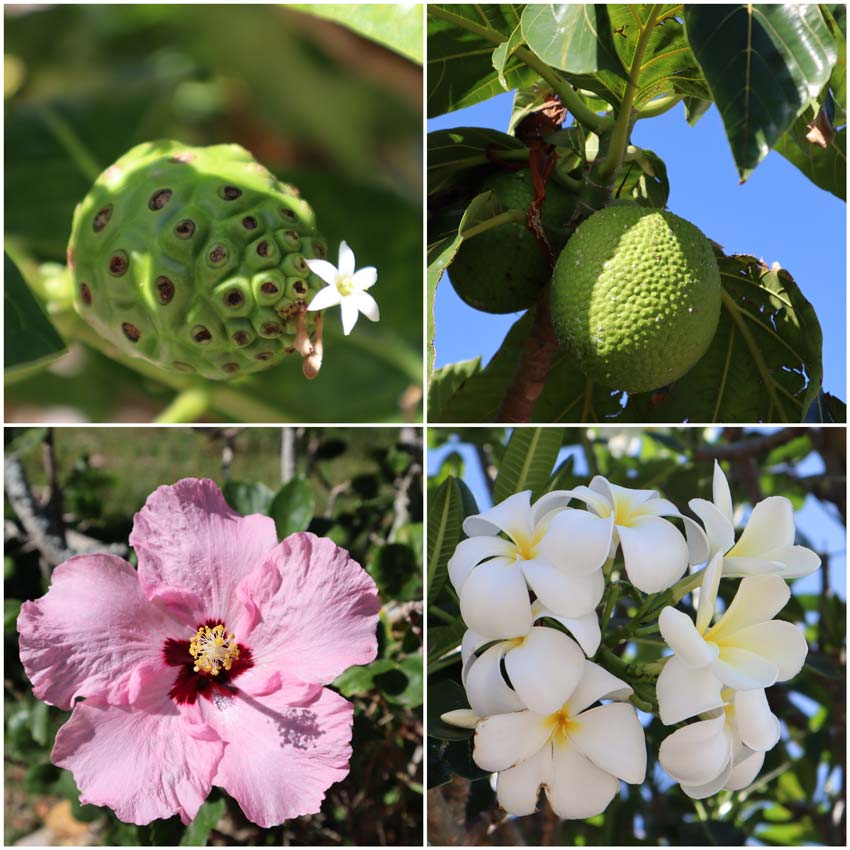
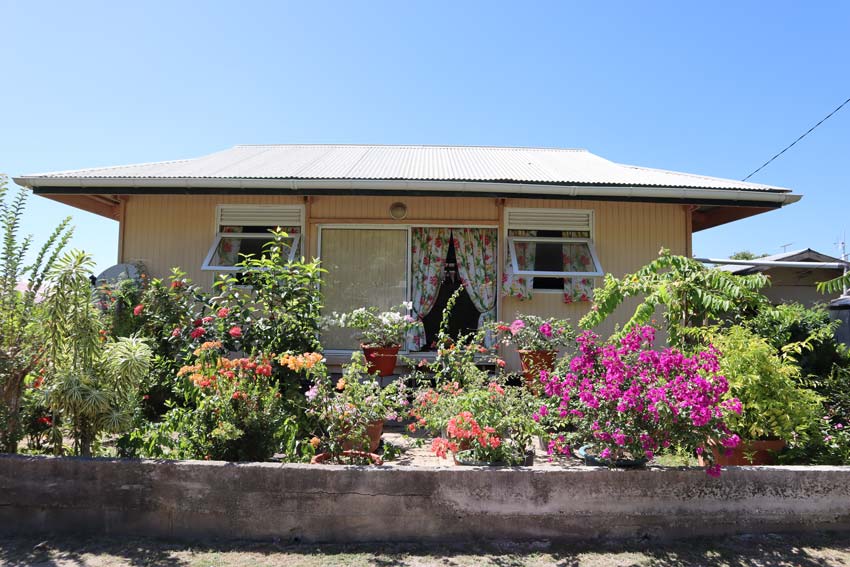
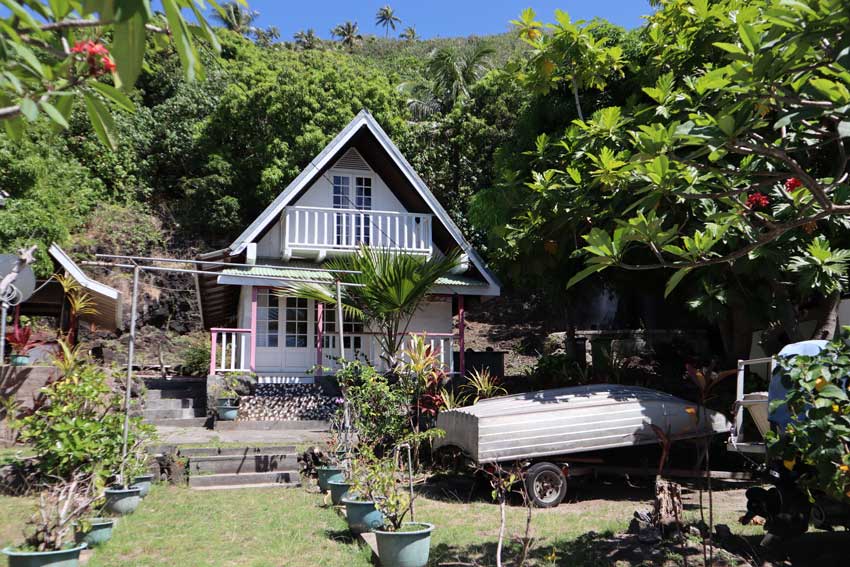
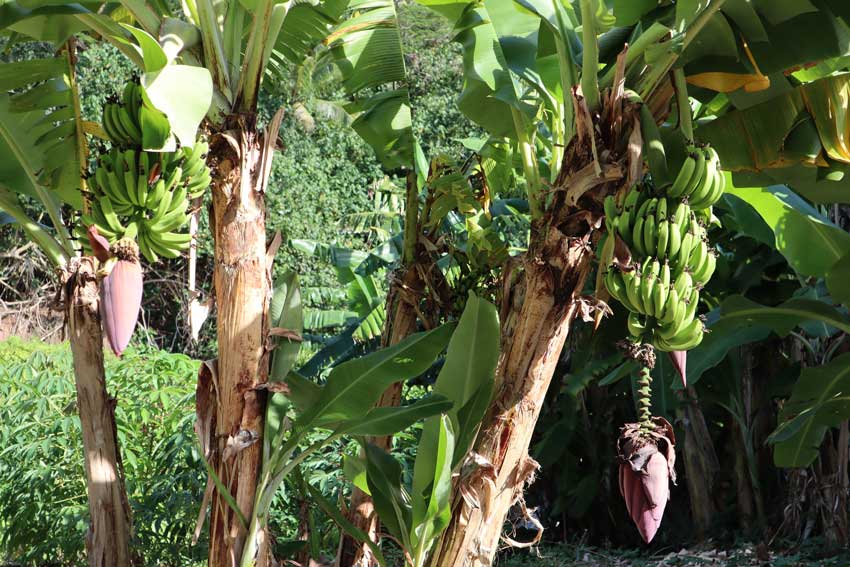
It’s Friday afternoon and locals start the weekend by catching up on some gossip at Tereia Beach while others are chilling with a cold Hinano beer in the shallow waters. The sun is beginning to set behind Motu Auira and palm branches are gently swaying in the trade wind. It’s time to head back to the pension for the first of four communal dinners. It’s a great opportunity to meet other travelers, albeit having to practice my limited French and to enjoy Dawn’s fine cooking. You better like fish if coming to French Polynesia!
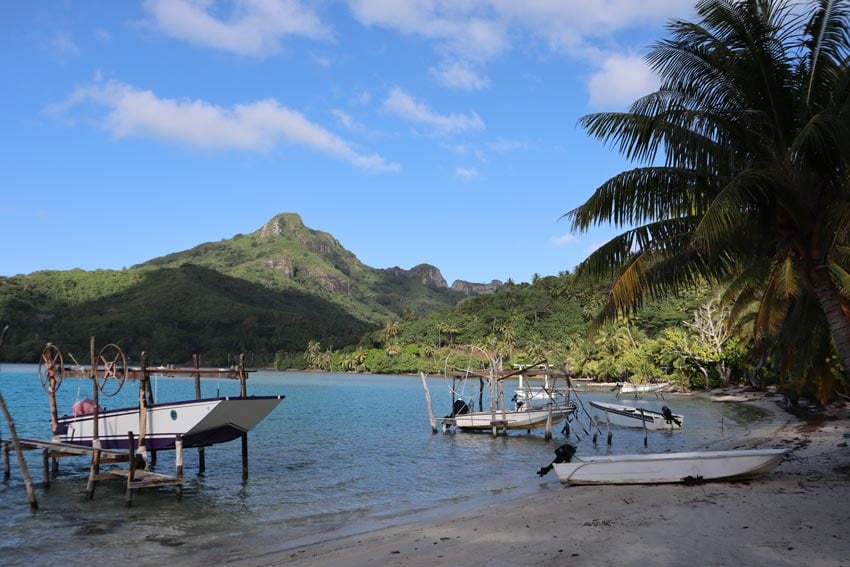
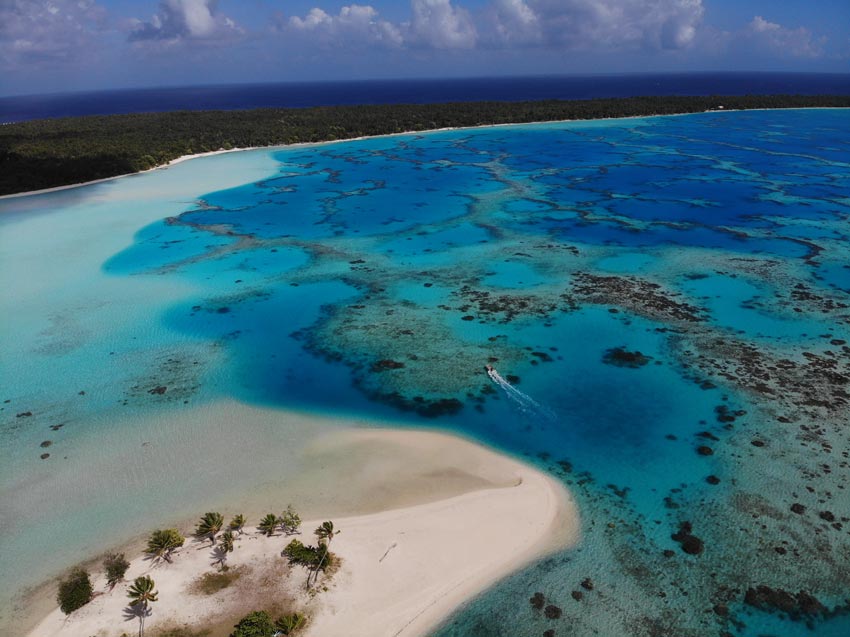
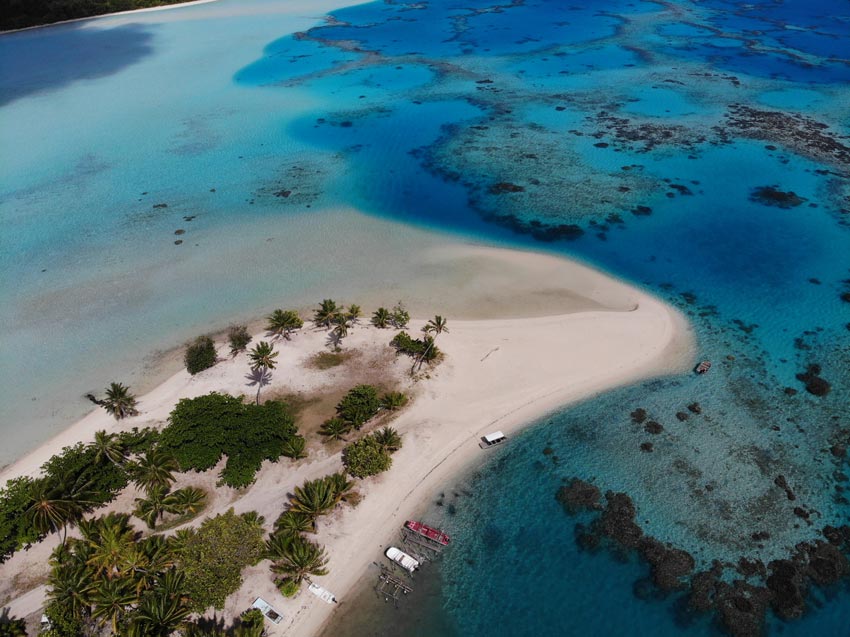
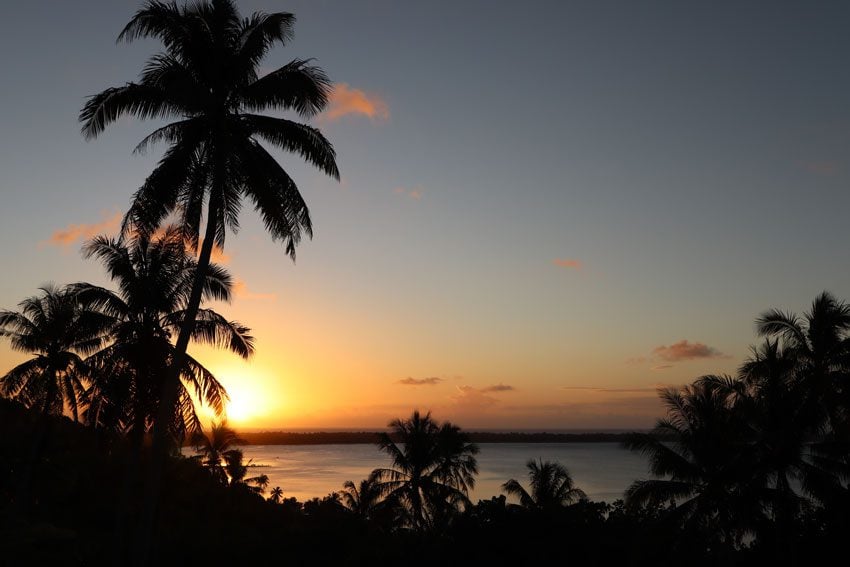
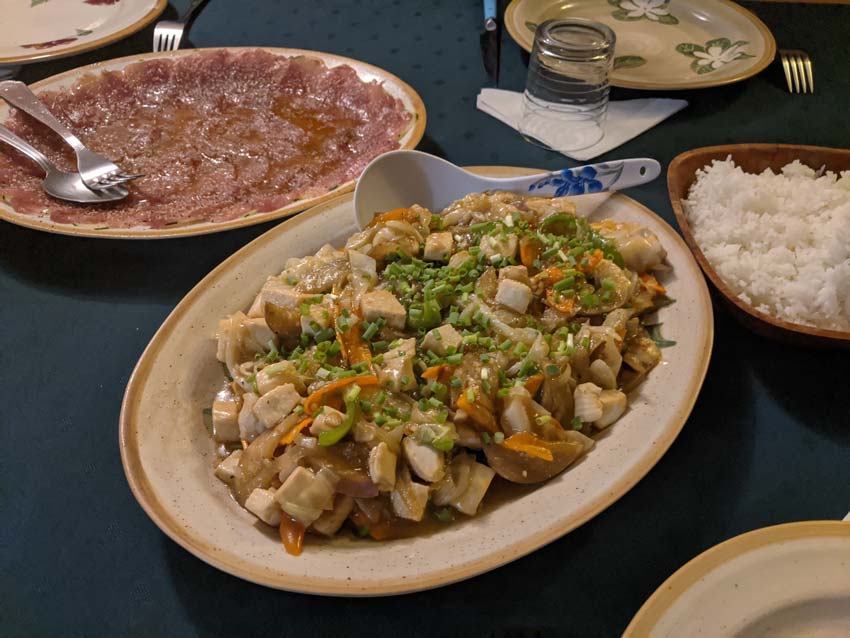
The rooftop of paradise
On the following day, I set out to climb the island’s highest peak, Mount Teurafaatiu (380m). It’s not a very long hike but under the heat of the sun, it’s a sweaty climb to the top. En route, the views keep getting better and better. There’s the airport, whose runway extends into the lagoon, Vai’ea Village and its church, and a handful of yachts moored for god-knows-how-long in the lagoon.
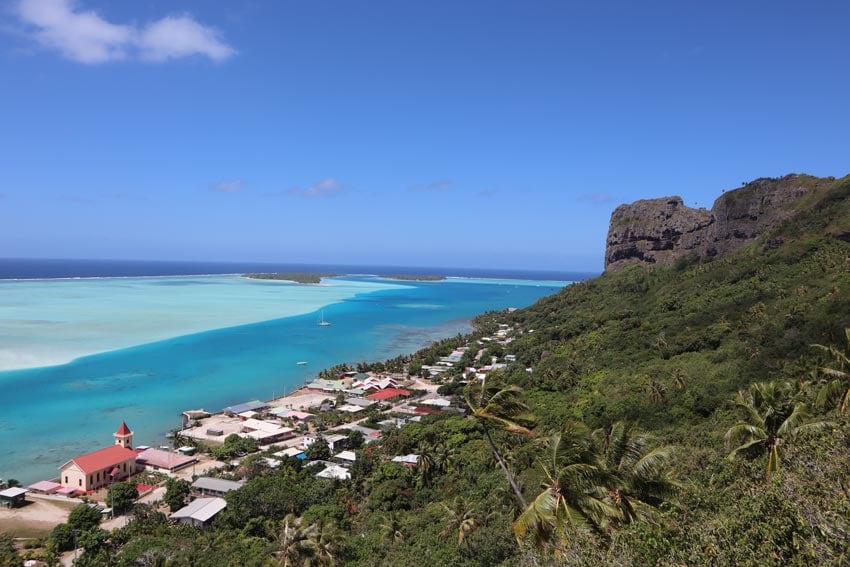
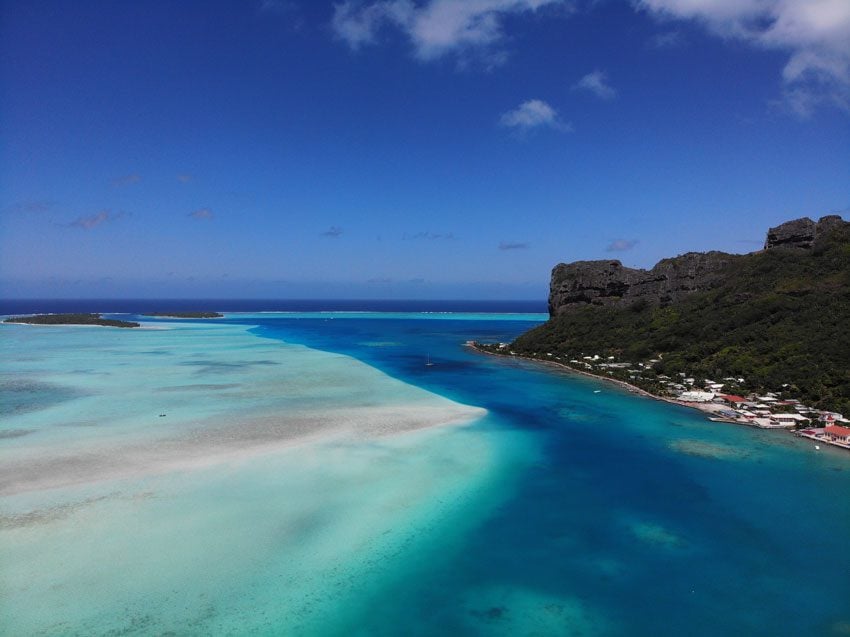
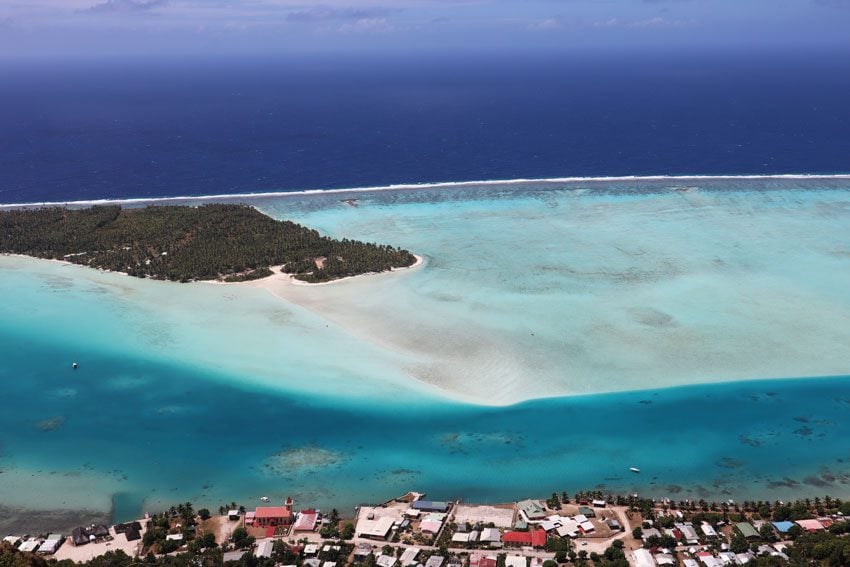
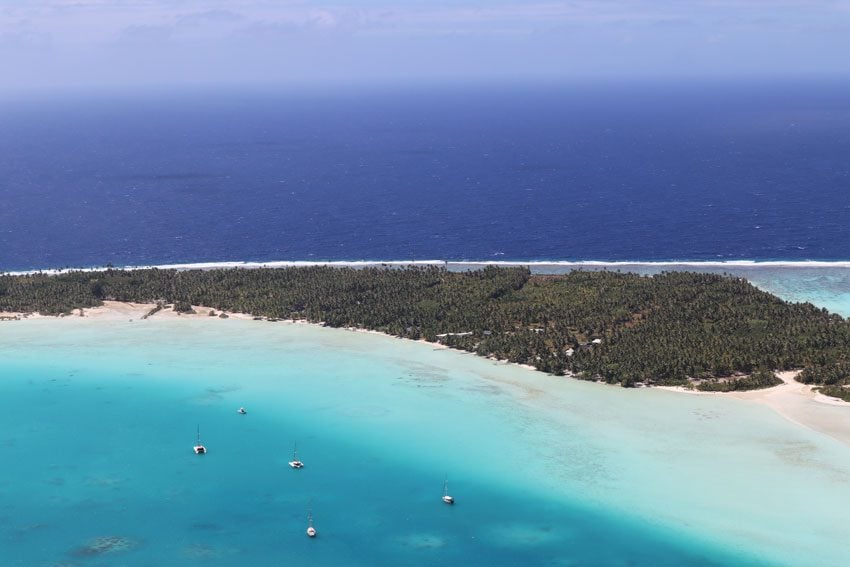
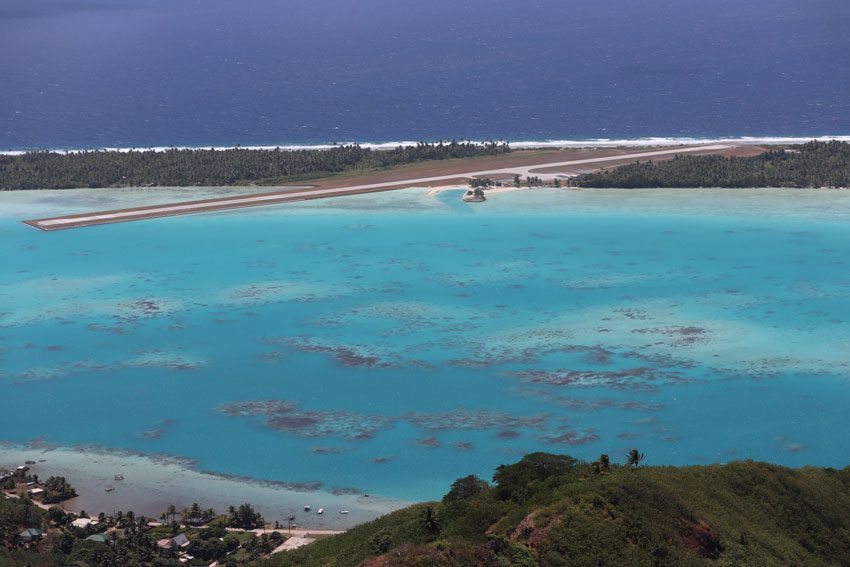
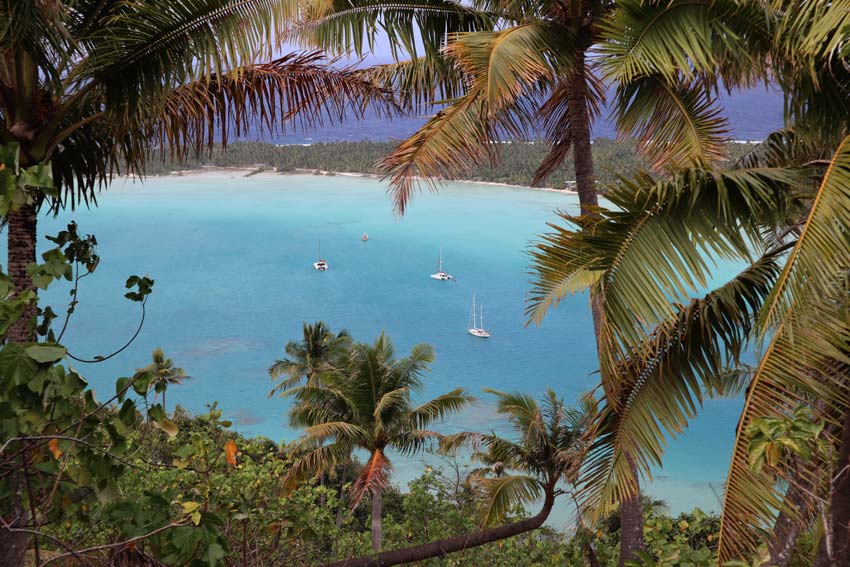
At the summit, a refreshing wind is a fitting prize for the arduous climb. From up here, it seems as though all the action happening on Maupiti at this exact moment can be seen. I park it for a good two hours before reluctantly descending back to the “real world”.
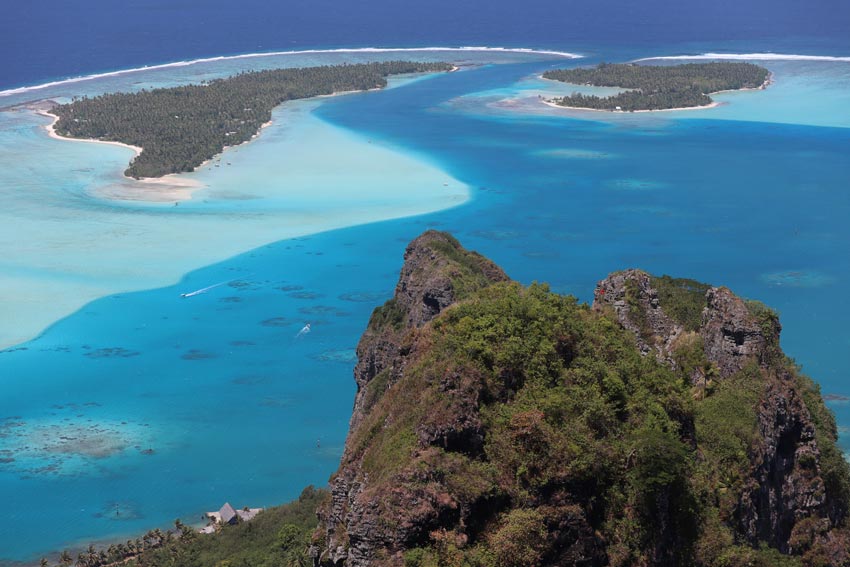
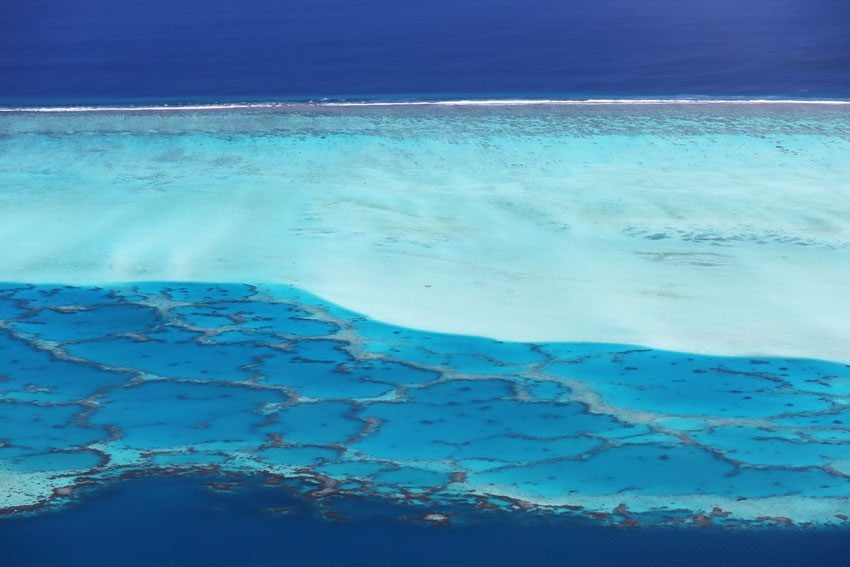
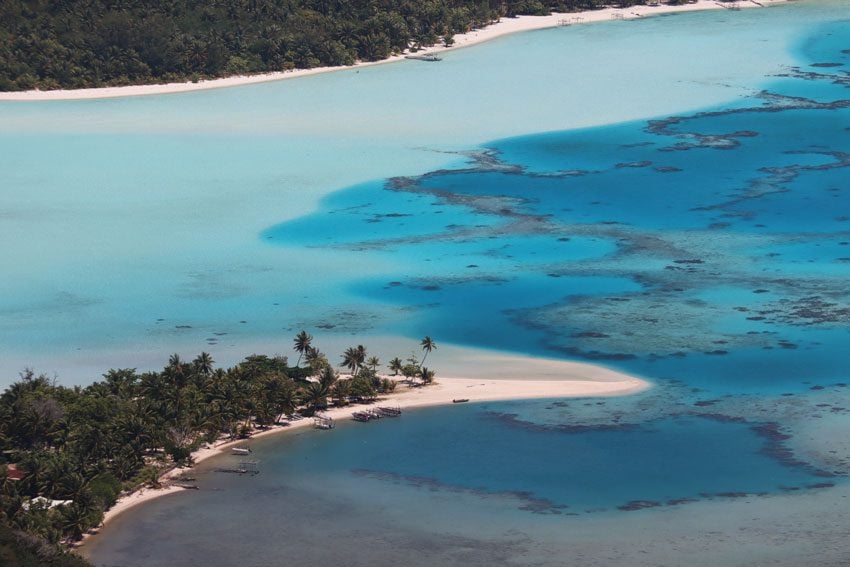
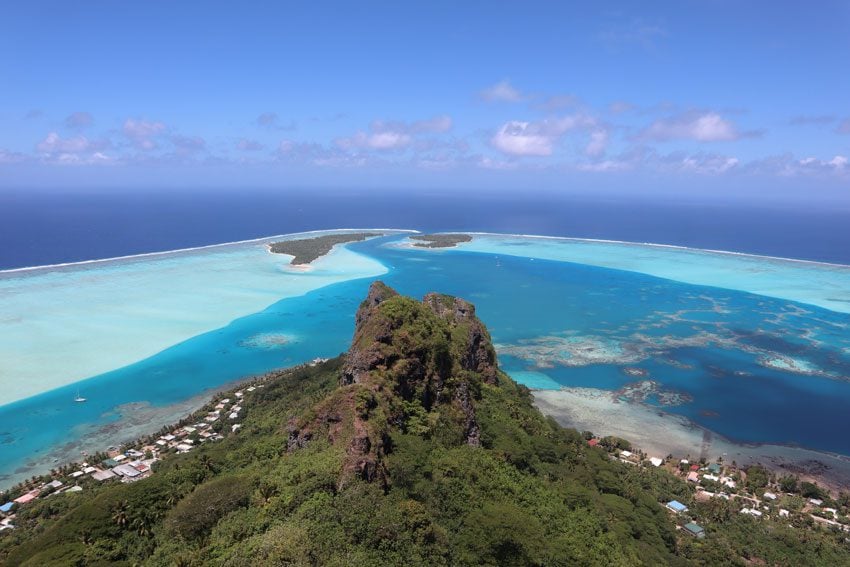
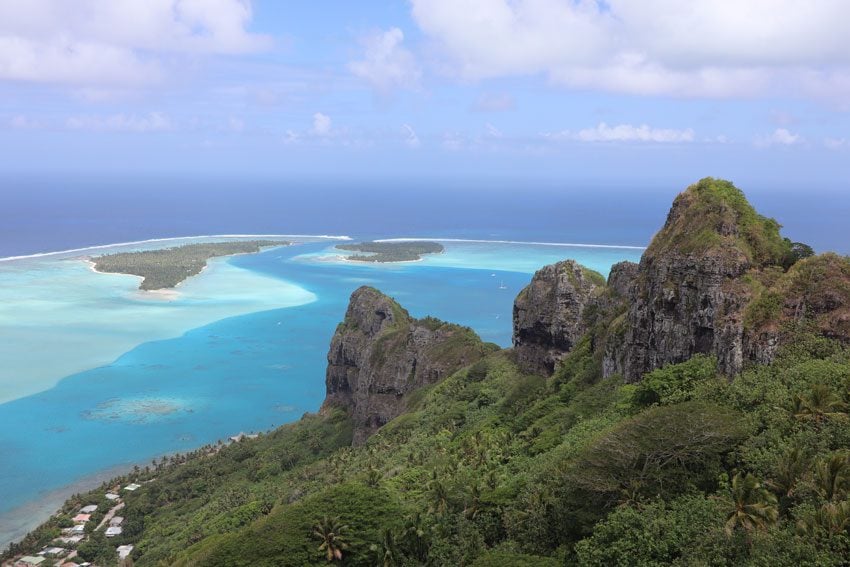
It’s now around 2 pm on a Saturday afternoon and there isn’t a soul around. Everyone must be napping in the shade. Heck, even the dogs are doing that. The only restaurant on the island should be open, but it’s not. That’s OK though as there are plenty of fresh mangos on the ground. I take the long road back to the pension and complete a full circle of Maupiti on foot.
Like Moses Parting the Red Sea
I kept the best of Maupiti for the final two days on the island. Very often in traveling, the best places you visit require some effort. Motu Auira is a great example of that, a large-sized islet on the western edge of the barrier reef. The only way to get there is by either hiring a local boat or walking for about one kilometer across a shallow part of the lagoon from the main island.
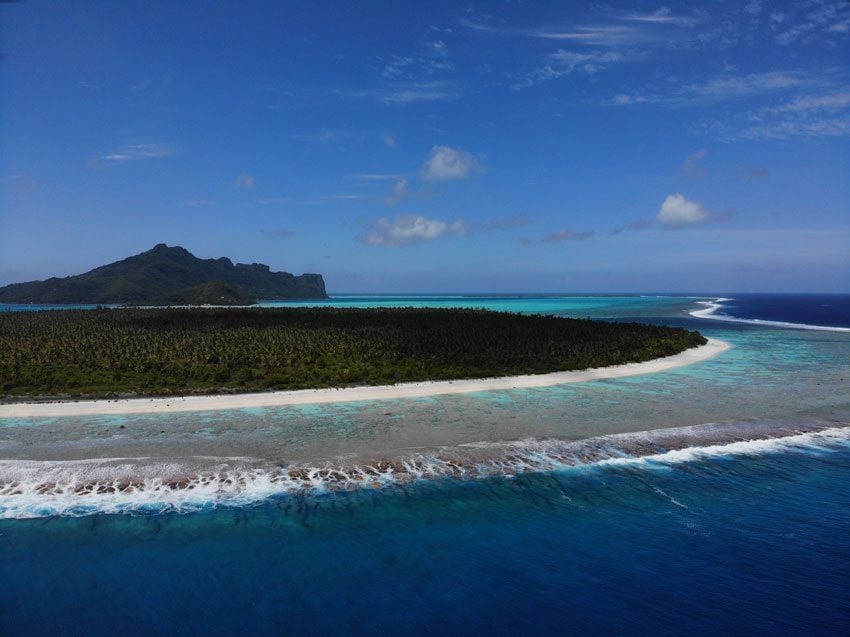
I return to Tereia Beach only to pick up a casse croute (baguette sandwich) from Snack Chez Mimi and begin parting the lagoon at a specific point to reach the motu. The white sand amplifies the sun’s rays and also makes it easy to spot eagle rays and small reef sharks attracted by the commotion. A fisherman is heading out to sea and offers a lift, but I prefer experience over comfort.
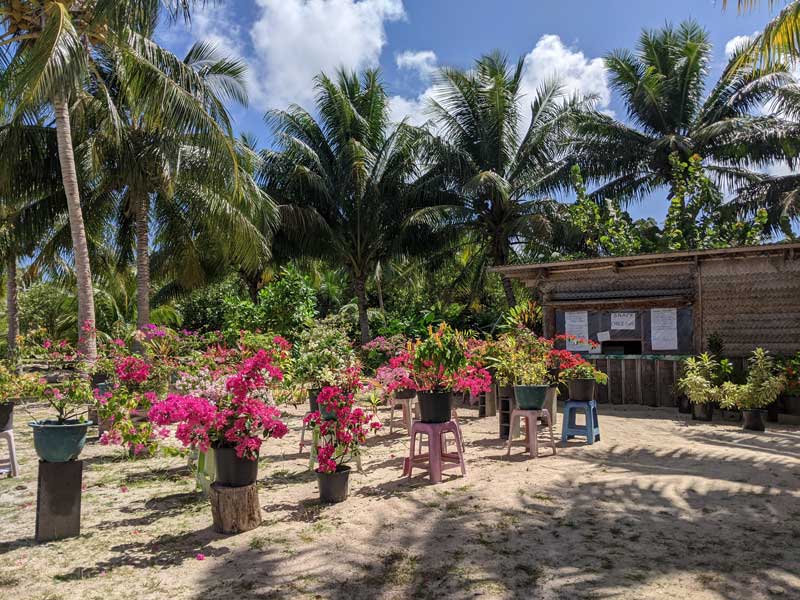
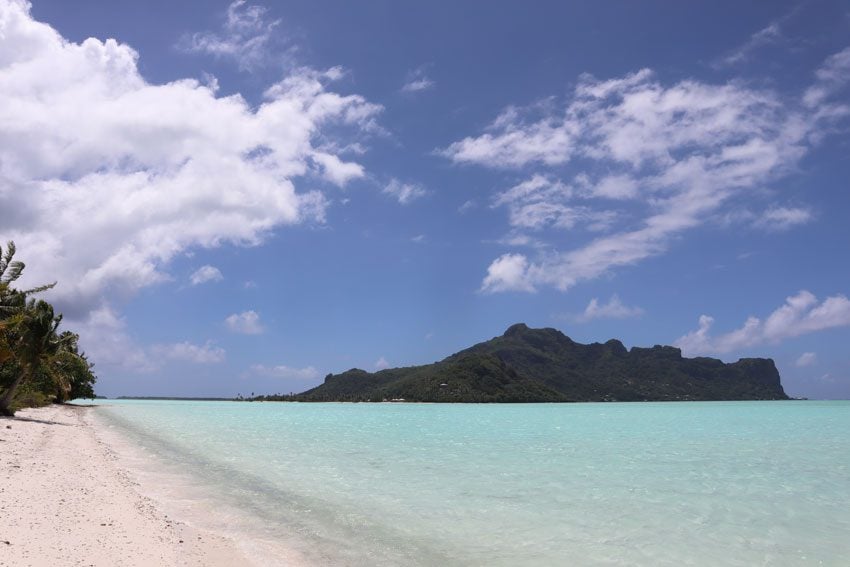
On Motu Auira, a handful of locals live on the lagoon side, but the interesting part is the reef side. Miles and miles of finely crushed coral sand serve as a partition between the blue lagoon and the coconut groves. Like a grand symphony, the reef breaks only 100 meters or so from the beach and the main island slowly disappears as you inch further to find the perfect spot. On a clear day, you can even see Bora Bora in the far distance. How different is the experience on either island…
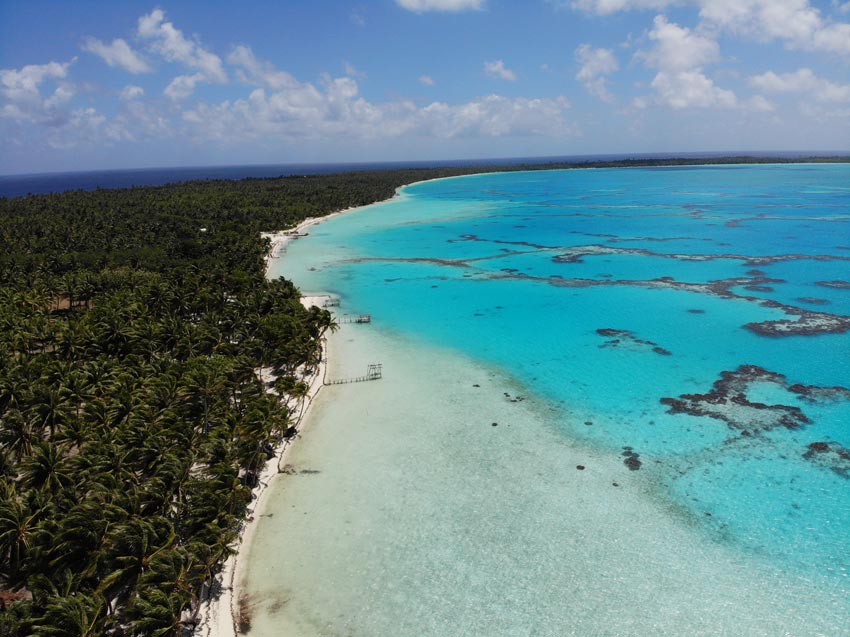
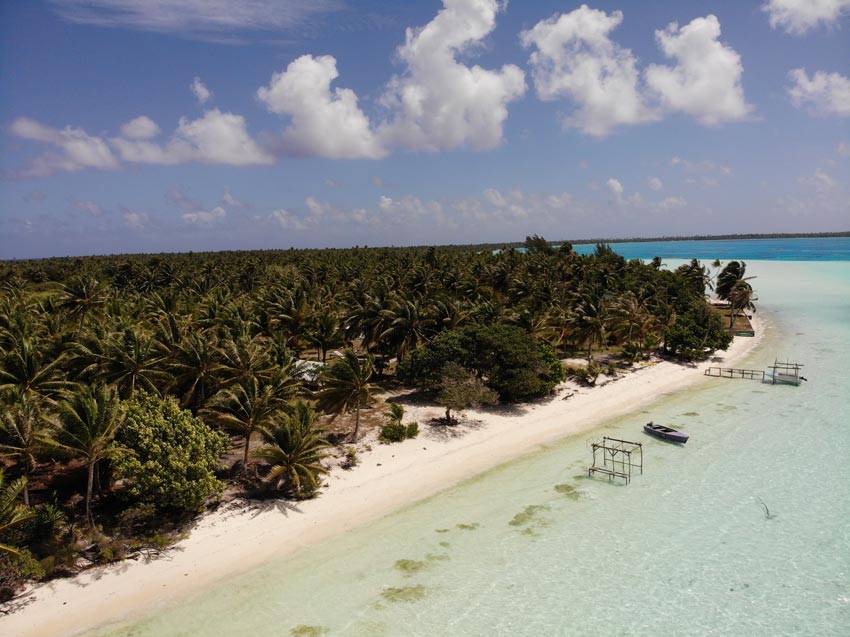
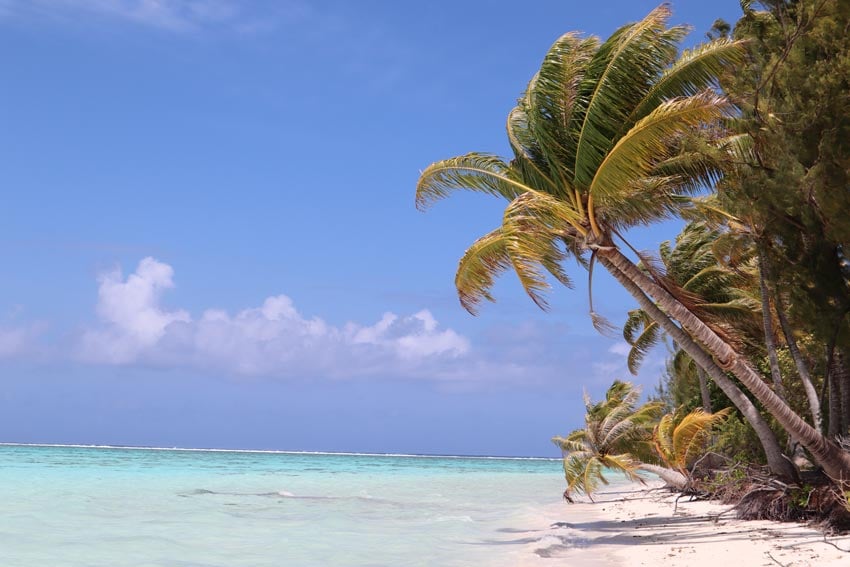
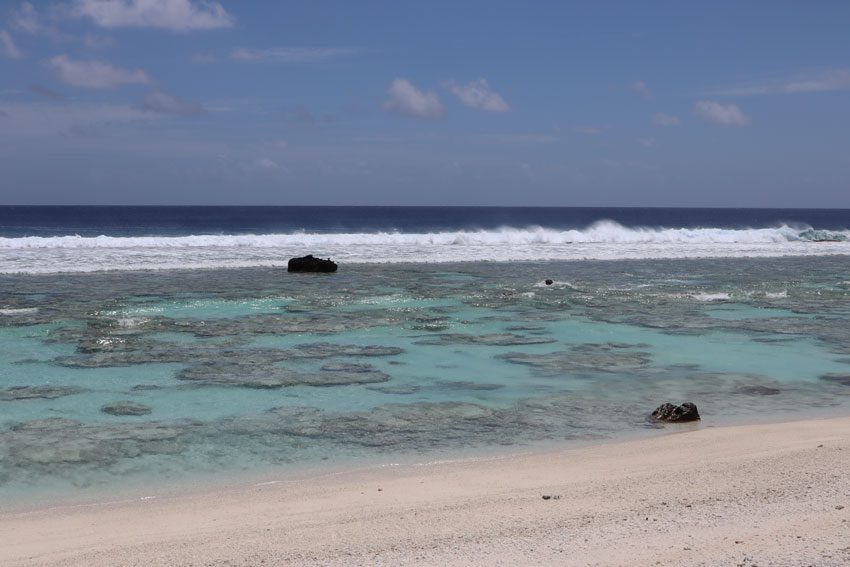
It’s just me and the hermit crabs on Motu Auira on this day and I fill the hours by alternating between reading, napping, beachcombing for shells, and snorkeling. Despite the heat, I sleep like a baby thanks to the reef break. Occasionally, I wake up to the sound of a descending airplane only to realize an unusually large wave just met its doom on the coral reef.
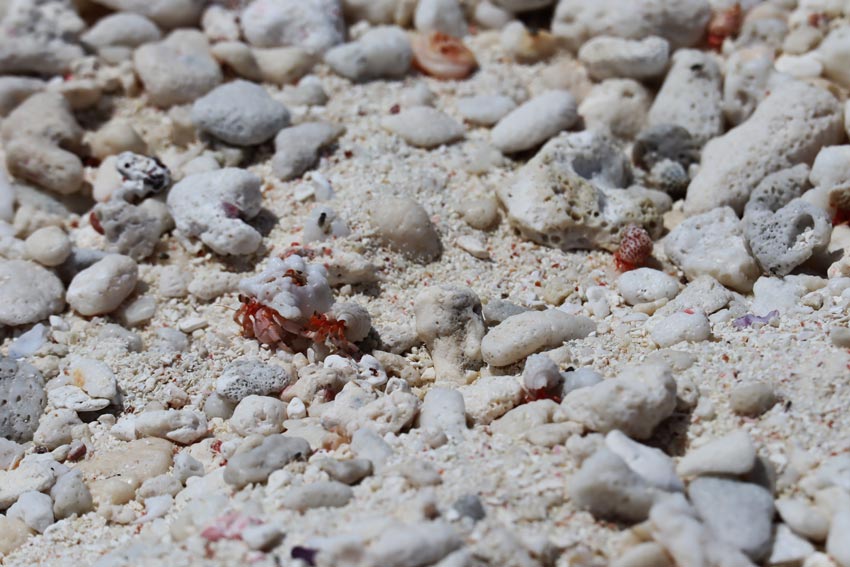
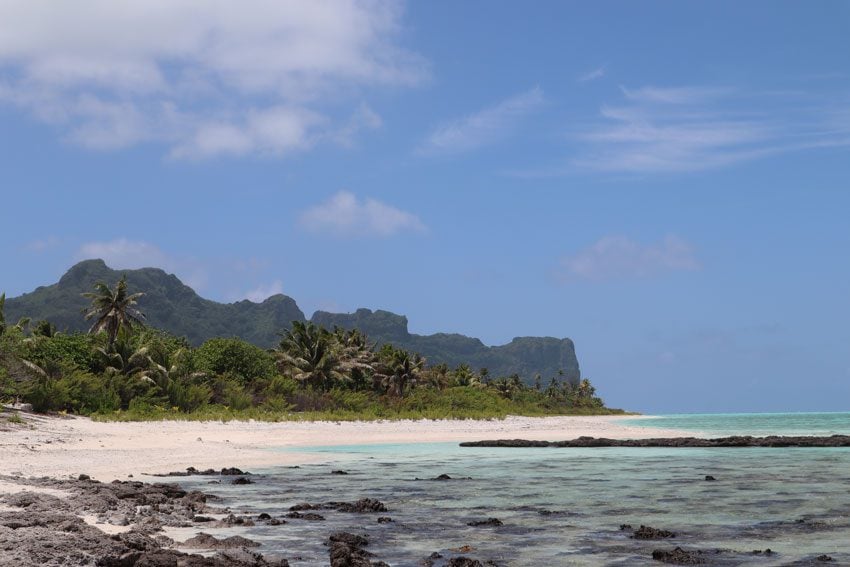
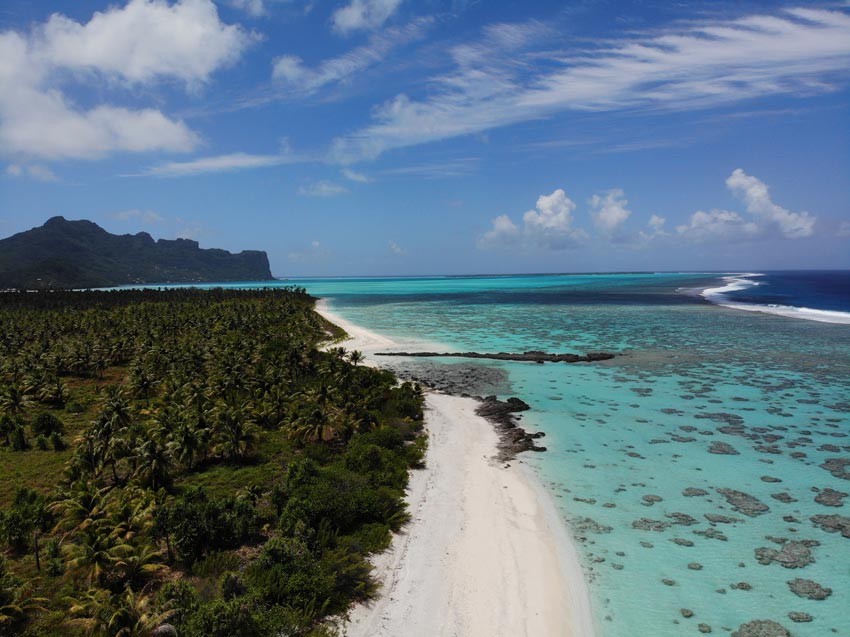
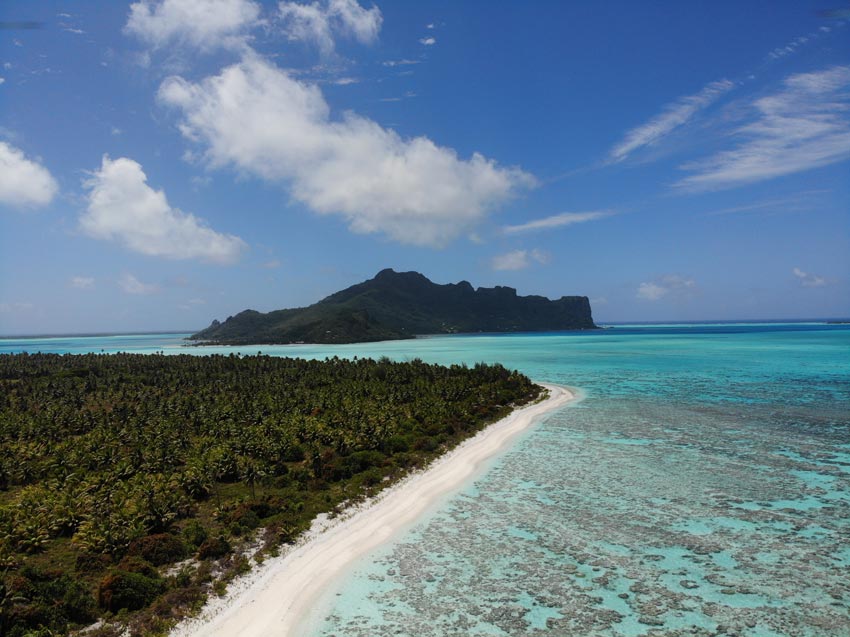
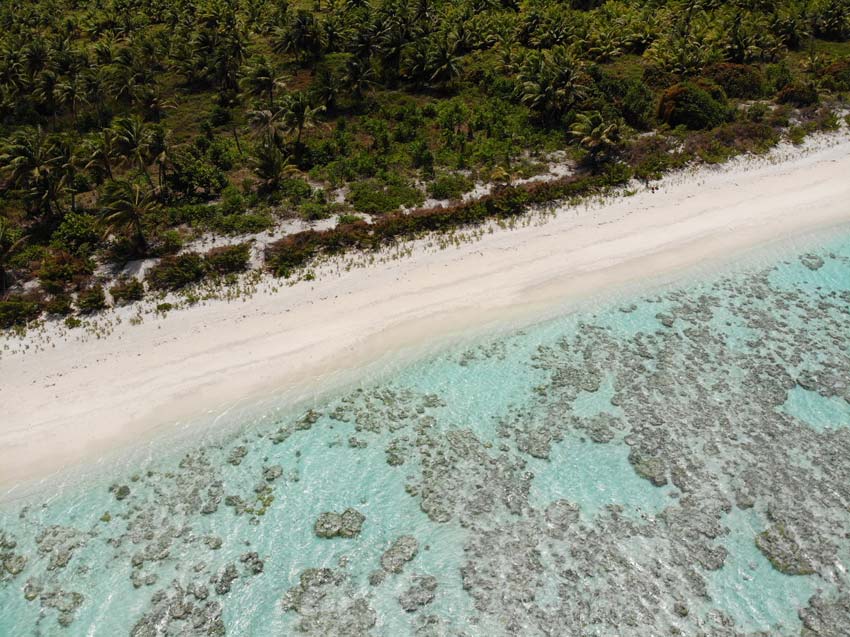
The snorkeling out here is superb. Maupiti’s signature colorful clams are abundant and you can even tread all the way to the reef’s edge to witness the crashing of the waves in person. Moray eel and reef sharks are the main things to look out for, the latter comb the lagoon on their own, which makes for a frightening encounter though they seem to be more scared than you.
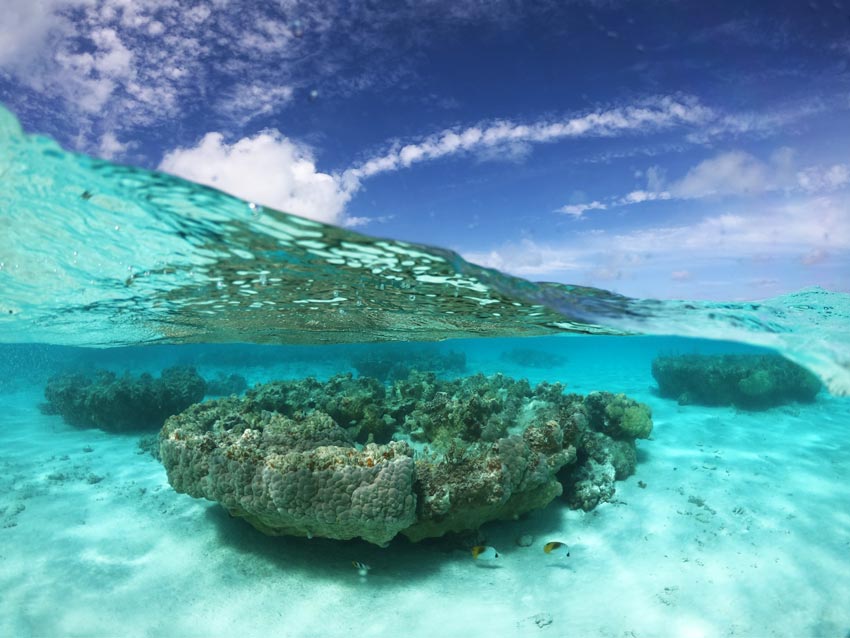
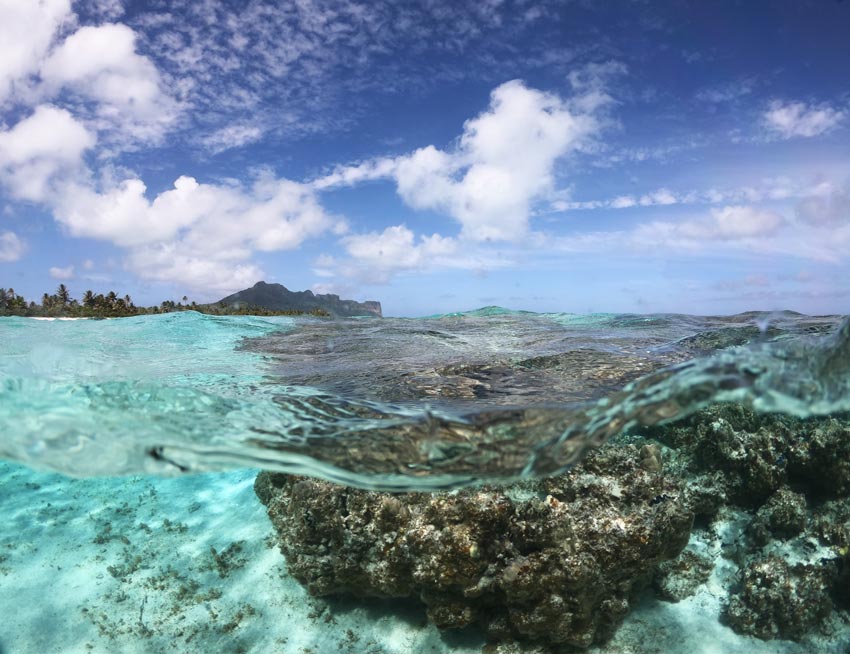
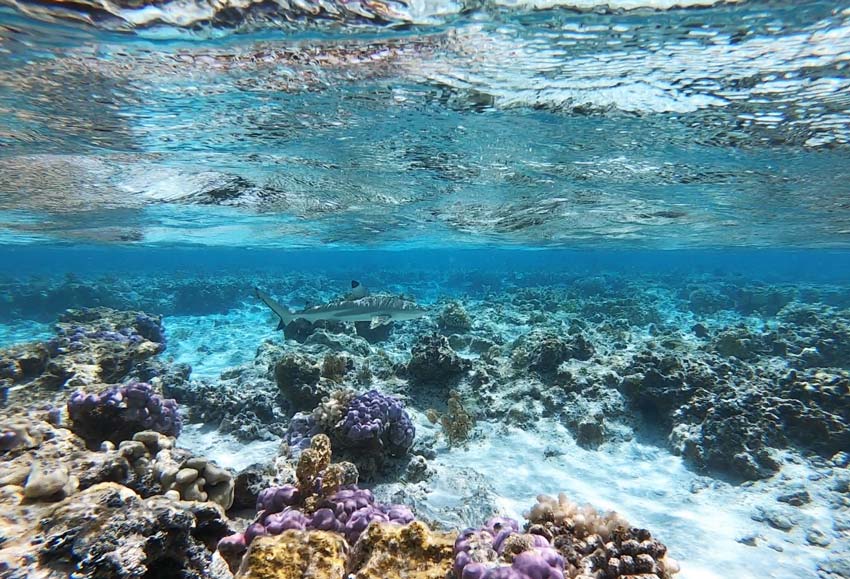
After another soothing nap, I notice a couple of fishermen trying to catch tonight’s dinner. One is dangerously walking on the reef holding a large net while the other is trying his luck throwing a spear from a boulder of raised dead coral. In Polynesia, dinner is always available, you just need to work for it.
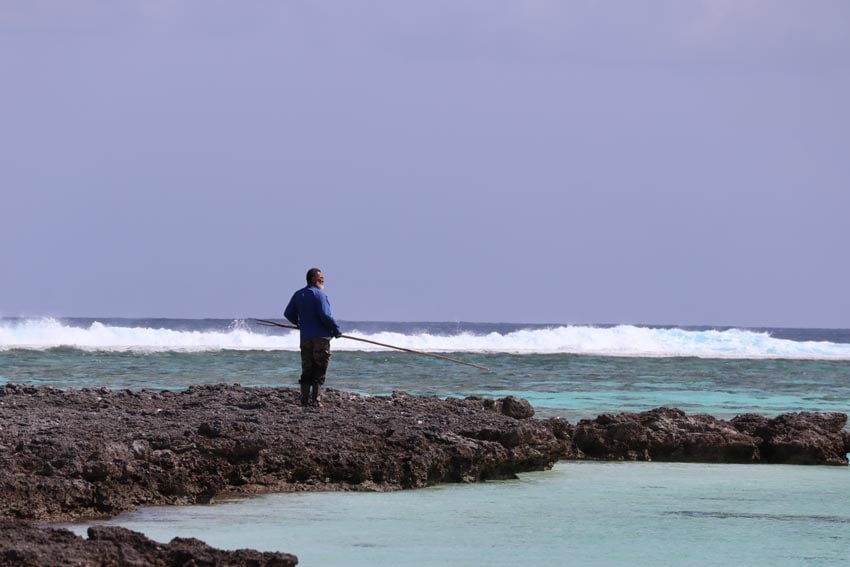
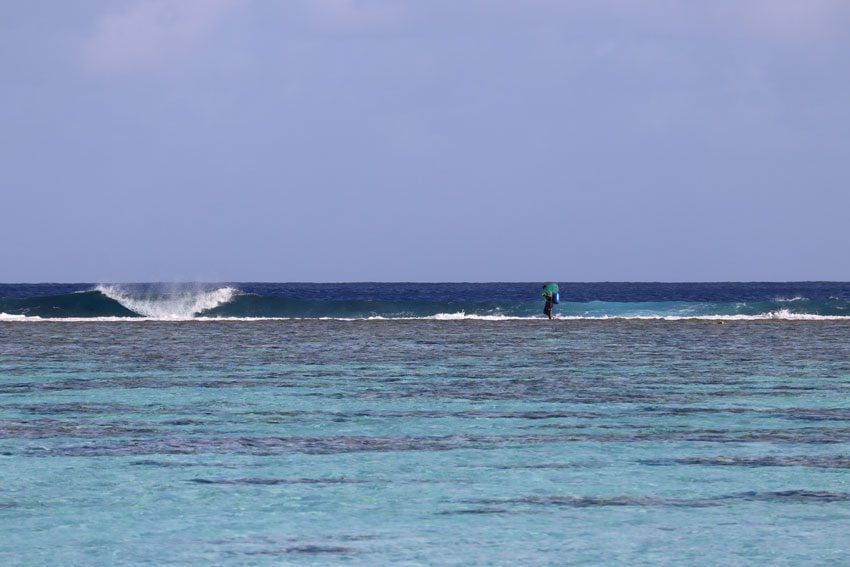
It’s time to head back to the main island before the sun sets. Tourists chilling back at Tereia Beach are staring at the crazy popa’a aqua walking across the lagoon. I get back in time for another glorious sunset, this time marveling at the ridge just behind the pension painted in gold.
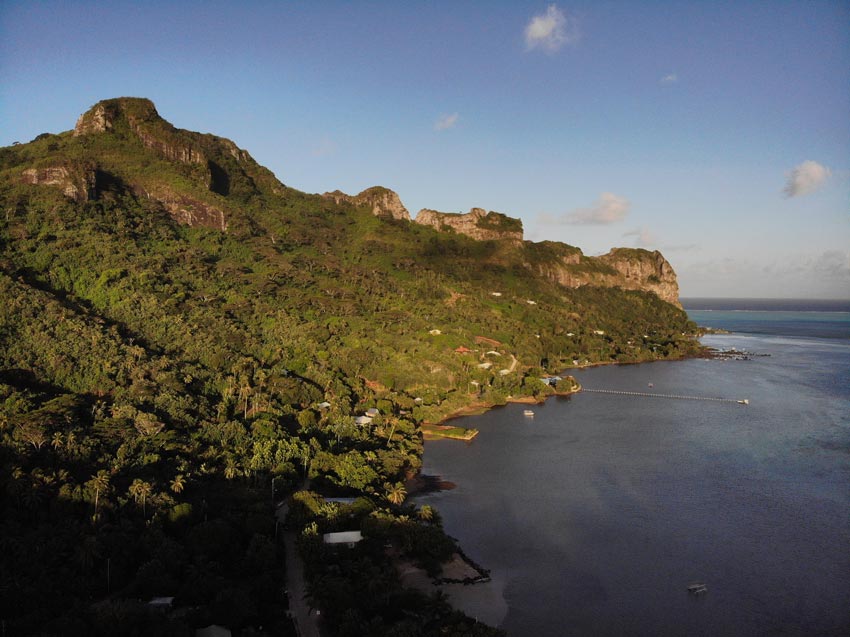
The next day, I was graciously offered by Dawn to join a lagoon tour to see some manta rays and enjoy a traditional BBQ on their private motu. It is something that every first-time visitor to Maupiti must do. But I head back to Motu Auira for one final day of playing Robinson Crusoe. I spend the final evening sitting on edge of the pension’s long jetty, contemplating life under a full moon and a night sky filled with stars. Will there ever be a fourth visit to Maupiti?
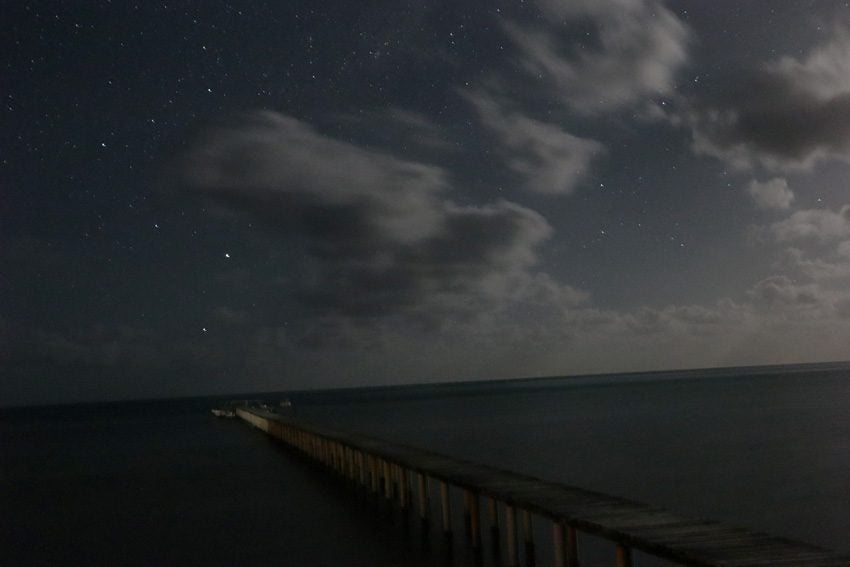
What’s Next?
In the next post, we’ll head north to the atolls of the Tuamotu group and explore Tikehau. Tikehau is famous for its pink sand beaches and rich lagoon, which Jacques Costeau claimed to contain a greater variety of fish species than any other place in French Polynesia. Stay tuned!
>> Read the next post from Tikehau >>
Tahiti, Tailor Made!
The Islands of Tahiti are among the last places to be colonized by mankind, 118 islands, each with its unique personality.
Get expert advice and assistance with planning your trip to the destination where tropical dreams come true!
